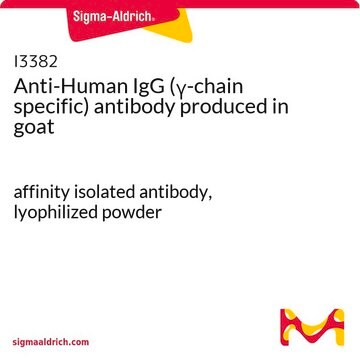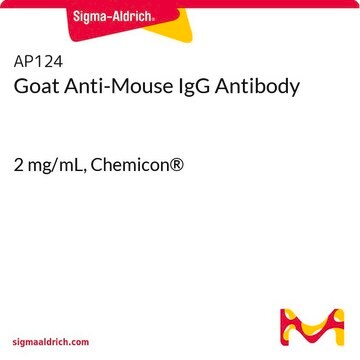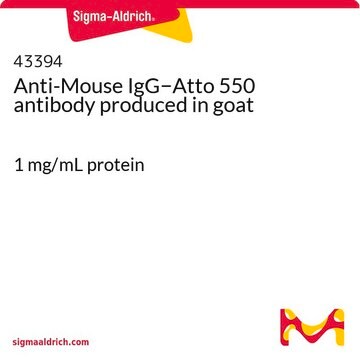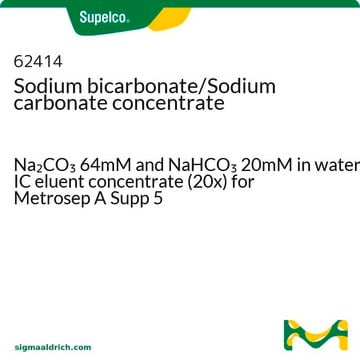78102
Anti-Mouse IgG - Atto 633 antibody produced in goat
~1 mg/mL IgG, affinity isolated antibody
Synonym(s):
Anti-Mouse IgG−Atto 633 antibody produced in goat, Atto 633 [goat-Anti-mouse IgG]
Sign Into View Organizational & Contract Pricing
All Photos(1)
About This Item
UNSPSC Code:
12352203
NACRES:
NA.46
Recommended Products
biological source
goat
Quality Level
conjugate
Atto 633 conjugate
antibody form
affinity isolated antibody
antibody product type
secondary antibodies
clone
polyclonal
contains
50% glycerol as stabilizer
species reactivity
mouse
concentration
~1 mg/mL IgG
fluorescence
λex 636 nm; λem 650 nm in PBS
storage temp.
−20°C
target post-translational modification
unmodified
Related Categories
General description
Immunoglobulin G (IgG) is a glycoprotein antibody that regulates immune responses such as phagocytosis and is also involved in the development of autoimmune diseases. Mouse IgGs have four distinct isotypes, namely, IgG1, IgG2a, IgG2b, and IgG3. IgG1 regulates complement fixation in mice.
Anti-mouse IgG (whole molecule) is purified from goat anti-mouse IgG antiserum to remove essentially all goat serum proteins, including immunoglobulins, which do not specifically bind to mouse IgG. The antibody preparation is solid phase adsorbed with human serum proteins to ensure minimal cross reactivity. Goat anti-mouse is conjugated to Atto 633 NHS and purified by gel permeation chromatography and dialysis to remove unbound dye. Atto 633-goat anti mouse IgG associates with mouse IgGs.
Anti-mouse IgG (whole molecule) is purified from goat anti-mouse IgG antiserum to remove essentially all goat serum proteins, including immunoglobulins, which do not specifically bind to mouse IgG. The antibody preparation is solid phase adsorbed with human serum proteins to ensure minimal cross reactivity. Goat anti-mouse is conjugated to Atto 633 NHS and purified by gel permeation chromatography and dialysis to remove unbound dye. Atto 633-goat anti mouse IgG associates with mouse IgGs.
Immunogen
purified mouse IgG (whole molecule).
Application
Atto fluorescent labels are designed for high sensitivity applications, including single molecule detection. Atto labels have rigid structures that do not show any cis-trans-isomerization. Thus these labels display exceptional intensity with minimal spect
Physical form
Solution in phosphate buffered saline and 5 mM sodium azide, pH 7.5, with glycerol 1:1
Analysis Note
Unconjugated dye ≤5% of total fluorescence
Legal Information
This product is for Research use only. In case of intended commercialization, please contact the IP-holder (ATTO-TEC GmbH, Germany) for licensing.
Disclaimer
Unless otherwise stated in our catalog or other company documentation accompanying the product(s), our products are intended for research use only and are not to be used for any other purpose, which includes but is not limited to, unauthorized commercial uses, in vitro diagnostic uses, ex vivo or in vivo therapeutic uses or any type of consumption or application to humans or animals.
Not finding the right product?
Try our Product Selector Tool.
Hazard Statements
Precautionary Statements
Hazard Classifications
Aquatic Chronic 3
Storage Class Code
10 - Combustible liquids
WGK
WGK 1
Flash Point(F)
Not applicable
Flash Point(C)
Not applicable
Personal Protective Equipment
dust mask type N95 (US), Eyeshields, Gloves
Choose from one of the most recent versions:
Already Own This Product?
Find documentation for the products that you have recently purchased in the Document Library.
Charlotte Calvet et al.
iScience, 25(12), 105628-105628 (2022-12-10)
Hearing depends on fast and sustained calcium-dependent synaptic vesicle fusion at the ribbon synapses of cochlear inner hair cells (IHCs). The implication of the canonical neuronal SNARE complex in this exocytotic process has so far remained controversial. We investigated the
Tharun Selvam Mahendran et al.
Frontiers in aging neuroscience, 12, 537712-537712 (2020-12-01)
Aggregated tau is a hallmark neuropathological feature in numerous neurodegenerative disorders. Previous studies aiming to validate aggregated tau pathology as a pathogenic driver of neurodegeneration in correlation to characteristic behavioral phenotypes have had shortcomings. Although studies on soluble tau pathology
Complement-fixing IgG1 constitutes a new subclass of mouse IgG.
P L Ey et al.
Nature, 281(5731), 492-493 (1979-10-11)
Structure and function of human and murine receptors for IgG.
J C Unkeless et al.
Annual review of immunology, 6, 251-281 (1988-01-01)
Our team of scientists has experience in all areas of research including Life Science, Material Science, Chemical Synthesis, Chromatography, Analytical and many others.
Contact Technical Service








